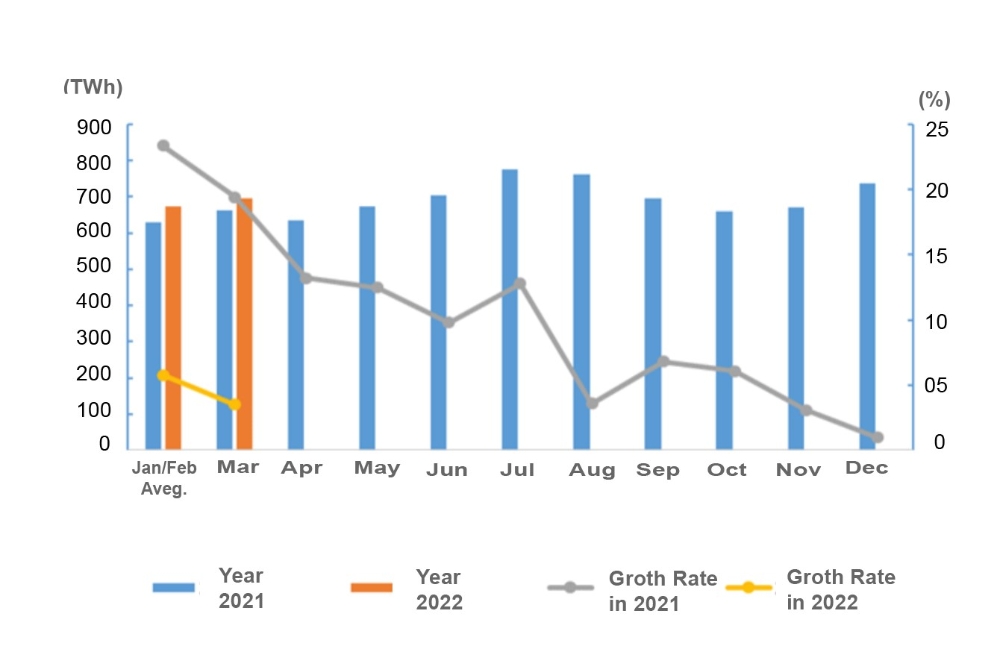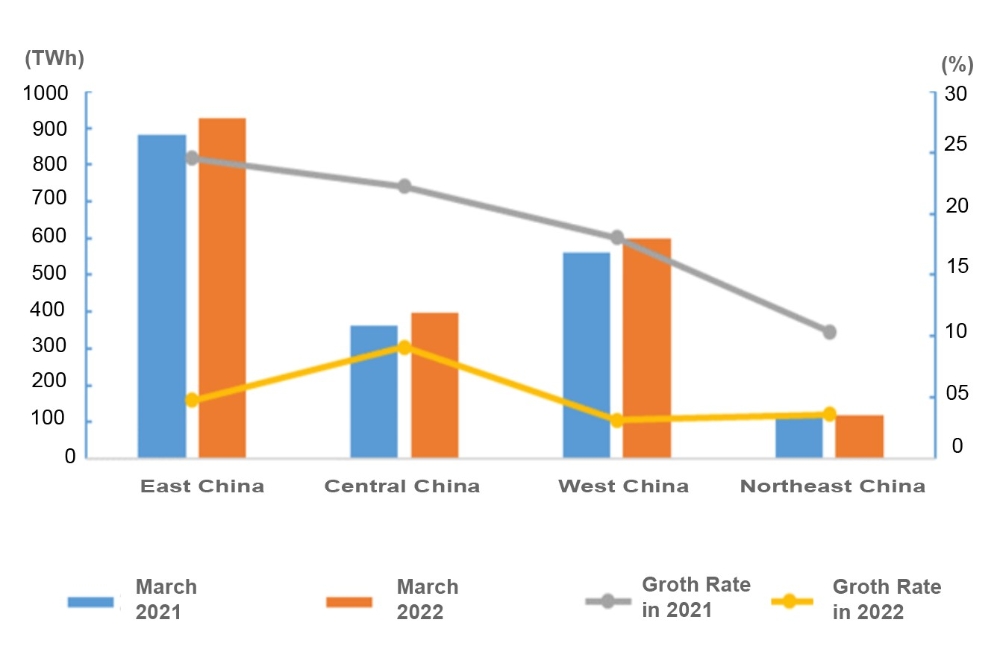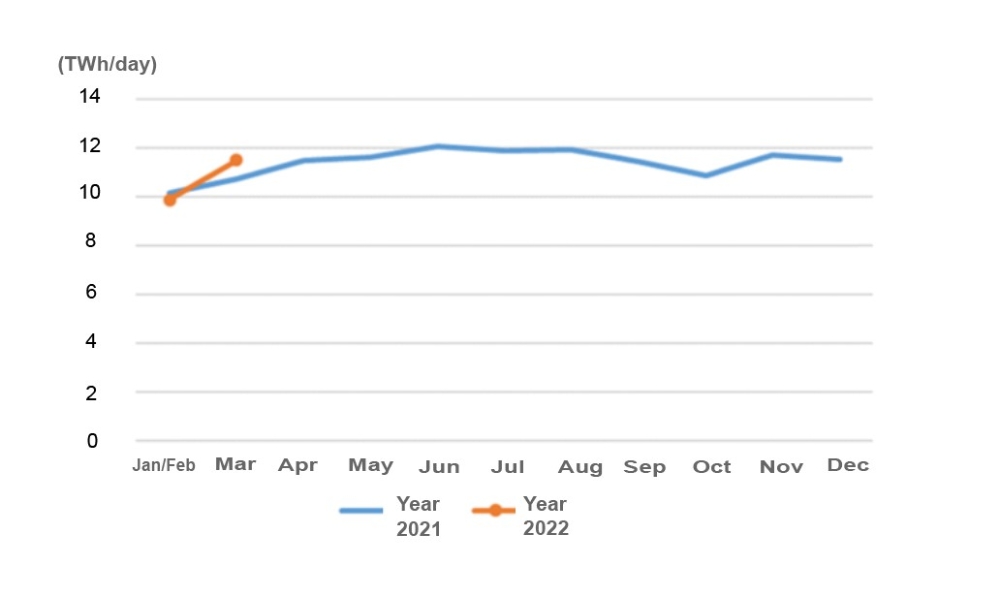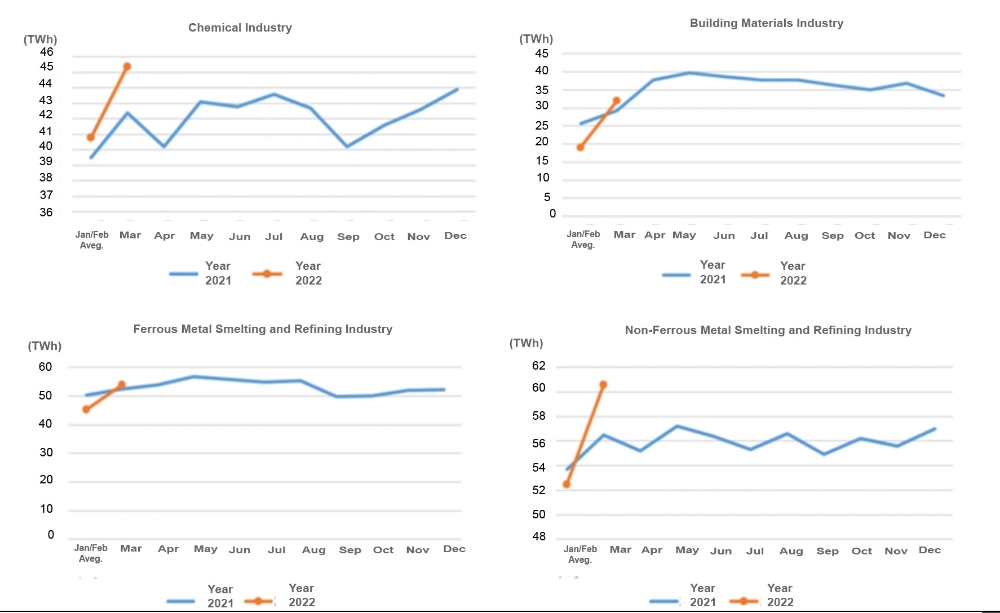from:China Electricity Councildate:2022-04-22
From January to March 2022, the electricity consumption of the whole society increased year-on-year, and the growth rate of the electricity consumption in the primary industry, tertiary industry and that of residential was higher than the national average. The growth rate of the electricity consumption of the 17 provinces nationwide exceeded the national average. In industrial and manufacturing sectors, the growth rate of the electricity consumption was lower than the national average. The electricity consumption of the chemical and non-ferrous metal industries had a positive growth, while the electricity consumption of the building materials and ferrous metal industries had a negative growth.
1. Overall electricity consumption
From January to March, the electricity consumption of the whole society reached 2,042.3TWh, a year-on-year increase of 5.0%, while in March, the electricity consumption of the whole society was 694.4 TWh, a year-on-year increase of 3.5%.
By sectors, from January to March, the electricity consumption of the primary industry was 24.1TWh, a year-on-year increase o 12.6%; the electricity consumption of the secondary industry was 1,321.4TWh, a year-on-year increase of 3.0%. The electricity consumption of the tertiary industry was 355.1TWh, a year-on-year increase of 6.2% and that of the residential was 341.7TWh, a year-on-year increase of 11.8%.

Figure 1: Electricity Consumption and Its Growth Rate by Month in 2021 and 2022
In March, the growth rate of the electricity consumption in the primary, secondary and tertiary industries was 12.3%, 2.3% and 4.0% respectively. The growth rate of the residential electricity consumption increased by 8.8% year-on-year.
2. Electricity consumption by region
From January to March, the electricity consumption of the Eastern, Central, Western and Northeastern China was 925.0TWh, 397.1TWh, 600.4TWh and 119.9TWh respectively, the growth rate of each region was 4.8%, 9.1%, 3.1% and 3.6% respectively.
In March, the growth rate of the electricity consumption of the Eastern, Central, Western and Northeastern China were 2.2%, 6.0%, 4.7% and 0.9% respectively.

Figure 2: Electricity Consumption and its Growth Rate in March by Region
From January to March, among the top 5 provinces with the highest growth rate of the electricity consumption in the whole society, the growth rate of Tibet was 21.2% (of which Lhasa increased by 19.6% year-on-year, driving Tibet's electricity consumption growth by 9.2 percentage points). Jiangxi’s electricity consumption growth rate was 12.7% (of which Ganzhou increased by 16.8% year-on-year, driving Jiangxi’s electricity consumption growth by 2.2 percentage points); Anhui’s electricity consumption growth rate was 11.7% (of which Hefei increased by 10.6% year-on-year, driving Anhui’s electricity consumption growth by 1.7 percentage points); Hubei’s electricity consumption growth rate was 11.5% (of which Wuhan increased by 12.2% year-on-year, driving Hubei’s electricity consumption growth by 3.3 percentage points); Hainan’s electricity consumption growth rate was 10.5% (of which Haikou increased by 9.9% year-on-year, driving Hainan’s electricity consumption growth by 2.7 percentage points).
In addition to the aforementioned provinces, there were 12 provinces whose electricity consumption growth rate exceeded the average level of the whole society, followed by: Zhejiang (9.6%), Hunan (9.6%), Sichuan (7.8%), Heilongjiang (7.7%), Shanxi (6.7%), Qinghai (6.6%), Fujian (6.5%), Henan (5.7%), Chongqing (5.6%), Beijing (5.4%), Jilin (5.3%) and Jiangsu (5.1%).
In March, the growth rates of the electricity consumption of the 19 provinces exceeded the national average, namely: Hunan (16.3%), Qinghai (15.5%), Tibet (12.7%), Ningxia (11.5%), Hainan (10.3%), Sichuan (9.9%), Inner Mongolia (9.7%), Yunnan (9.3%), Chongqing ( 8.3%), Heilongjiang (6.7%), Shaanxi (6.2%), Zhejiang (6.1%), Anhui (6.1%), Fujian (5.9%), Beijing (5.5%), Jiangxi (5.2%), Hubei (5.1%) ), Shanxi (5.1%) and Guangdong (3.8%).
3. Electricity consumption in industrial and manufacturing sector
From January to March, the industrial electricity consumption nationwide reached 1,298.0TWh, a year-on-year increase of 3.1%, 20.8 percentage points dropped compared to the growth rate of the same period last year, accounting for 63.6% of the overall electricity consumption. In March, the industrial electricity consumption nationwide reached 471.3TWh, a year-on-year increase of 2.1%, 18.7 percentage points dropped compared to the growth rate of the same period last year, accounting for 67.9% of the overall electricity consumption.
From January to March, the electricity consumption of the manufacturing industries nationwide was 968.6TWh, a year-on-year increase of 2.3%, 24.3 percentage points dropped compared to the growth rate of same period of the previous year, while the electricity consumption of the four energy-intensive industries totaled 534.1TWh, increased by 0.5% year-on-year, with the growth rate dropped by 18.4 percentage points from the same period of the previous year. The electricity consumption of the high-tech and equipment manufacturing industry was 203.3TWh, an increase of 5.0% year-on-year, 39.0 percentage points dropped compared with the same period of the previous year. The electricity consumption of consumer goods manufacturing industry was 123.0TWh, an increase of 2.9% year-on-year, 31.8 percentage points dropped compared to the same period of the previous year. The electricity consumption of other manufacturing industries was 108.3TWh, a year-on-year increase of 6.4%, 24.3 percentage points dropped compared to the same period of the previous year.
In March, the electricity consumption of the manufacturing industries nationwide was 356.1TWh, a year-on-year increase of 5.7%, 20.7 percentage points dropped compared to the growth rate of same period of the previous year. The average daily electricity consumption of the manufacturing industries was 11.49 TWh/day, an increase of 0.77TWh/day over the same period of the previous year, while the electricity consumption of the four energy-intensive industries totaled 191.9TWh, increased by 3.9% year-on-year, with the growth rate dropped by 16.2 percentage points from the same period of the previous year. The electricity consumption of the high-tech and equipment manufacturing industry was 76.0TWh, an increase of 6.9% year-on-year, 32.5 percentage points dropped compared with the same period of the previous year. The electricity consumption of consumer goods manufacturing industry was 47.7TWh, an increase of 7.9% year-on-year, 22.4 percentage points dropped compared to the same period of the previous year. The electricity consumption of other manufacturing industries was 40.6TWh, a year-on-year increase of 9.9%, with the growth rate dropped by 22.1 percentage points compared to the same period of the previous year.

Figure 3: Average Daily Electricity Consumption of Manufacturing by Month in 2021 and 2022
4. Electricity consumption in energy-intensive industries
From January to March, the electricity consumption of the chemical industry was 131.7TWh, a year-on-year increase of 4.2%, with the growth rate dropped by 9.8 percentage points compared to the same period of the previous year. The electricity consumption of the building materials industry was 79.7TWh, decreased by 1.2% year-on-year, with the growth rate dropped by 42.1 percentage points compared to the same period of the previous year. The electricity consumption of the ferrous metal smelting and refining industry was 150.6TWh, a year-on-year decrease of 2.6%, with the growth rate dropped by 23.5 percentage points compared to the same period of the previous year. The electricity consumption of non-ferrous metal smelting and refining industry was 170.2TWh, a year-on-year increase of 1.2%, with the growth rate dropped by 10.8 percentage points compared to the same period of the previous year.
In March, the electricity consumption of the chemical industry was 45.5TWh, an increase of 3.0% year-on-year, with the growth rate dropped by 10.7 percentage points compared to the same period of the previous year. The electricity consumption of the building materials industry was 32.0TWh, increased by 9.4% year-on-year, with the growth rate dropped by 31.5 percentage points compared to the same period of the previous year. The electricity consumption of the ferrous metal smelting and refining industry was 54.0TWh, an increase by 2.0% year-on-year, with the growth rate was 24.2 percentage points lower than the same period of the previous year. The electricity consumption of non-ferrous metal smelting and refining industry was 60.6TWh, a year-on-year increase of 3.5%, with the growth rate dropped by 7.9 percentage points compared to the same period of the previous year.

Figure 4: Monthly Electricity Consumption of Key Industries in 2021 and 2022
Tel:+86-25-84152563
Fax:+86-25-52146294
Email:export@hbtianrui.com
Address:Head Office: No.8 Chuangye Avenue, Economic Development Zone, Tianmen City, Hubei Province, China (Zip Code: 431700) Nanjing Office: Room 201-301, Building K10,15 Wanshou Road,Nanjing Area, China (Jiangsu) Pilot Free Trade Zone,Jiangsu Province,China (Zip Code:211899)
